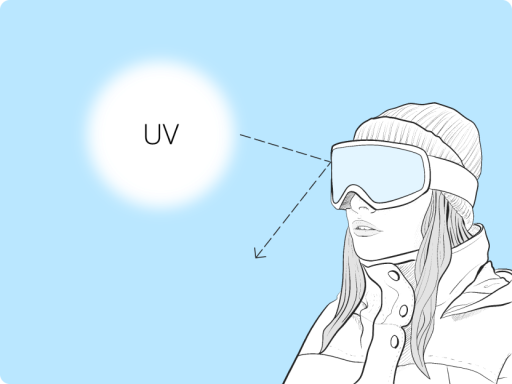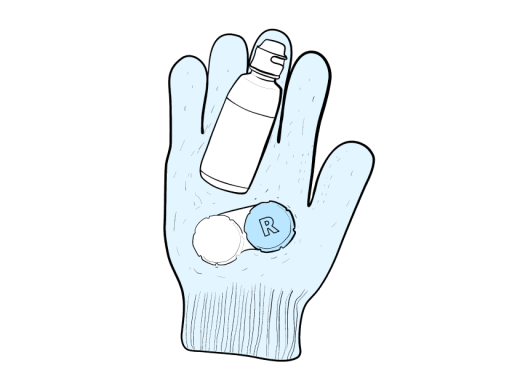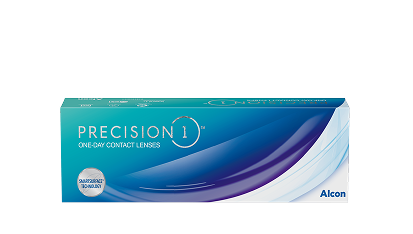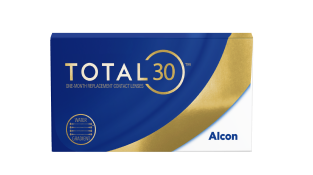Contact Lenses and Care
Can I Ski (and Play Sports) Wearing Contact Lenses?
5 mins read
If you enjoy winter sports, you’ll know how much glasses like to steam up, leaving you in a mist. You can use anti-fog wipes and sprays, but you’ll still be left wearing an uncomfortable construction which has a strange urge to break, fall off or obscure your peripheral vision.
Spectacles under your goggles feel uncomfortable, look weird and are liable to snap just when you need them the most. By contrast, contact lenses give you clear all-round vision and don’t slip down your nose, distort your view or get streaked with rain.

If you plan to take advantage of these benefits by wearing contact lenses whilst skiing, snowboarding or ice skating, make sure you wear UV-blocking sunglasses or goggles on top. Everyone—with or without contact lenses—should wear sunglasses on the slopes, since they reduce the strong sunlight’s blinding intensity and (most importantly) protect your eyes from damaging ultraviolet (UV) light.
UV rays can reach your eyes even when the sun’s not shining. Snow reflects these harmful rays into your face, so the effect is like sunbathing in 40°C heat, without eye protection! These UV rays can damage your eyes and cause photokeratitis—a condition which burns and damages your cornea. You will not enjoy what follows.
The effects can include pain and discomfort, swelling, light sensitivity, headaches, blurriness, distorted colours and even a temporary loss of vision.
If any of this starts to happen, the obvious advice is: stop wearing your lenses but not your sunglasses. See your optician as soon as you can. Your eyes are likely to heal quickly, but they’re too important to be left unchecked.
Lenses work at any altitude. As far back as 1975, using lens technology that has now been vastly improved, climbers on Mount Everest wore lenses at heights up to 7,315 meters!
However, your contact lenses may dry out in the cold (just as they do with central heating). The key is to keep them hydrated. You first line of support is to blink. The second is to use rewetting eye drops suited to your lenses—check with your optician to get the right ones. If you can, apply them in a clean, warm environment like a hut, chalet or café, rather than on a ski-lift or the slopes, in case going back to your accommodation is inconvenient. Your third option is to switch to glasses if the dryness persists.
Although your lenses will never freeze, if it gets especially cold your solution might. Consider keeping your kit (lens case with the lenses, solution, and/or supply of daily disposables) warm in your sleeping bag, if you ever camp out in extreme conditions.
You can wear monthly replacement contact lenses to ski, but daily disposables are a particularly good idea when on the slopes: you’re unlikely to have access to comfortable facilities for cleaning monthly replacement contact lenses, which is of course made harder with frozen fingers! If you’re a regular monthly replacement contact lenses user planning a ski trip or chilly holiday, a wise move is to ask your optician to switch you to daily disposables, temporarily.
Along with winter sports, lenses are great in the gym, for running outside, and even for contact sports like football and rugby. They’re ideal on the tennis or squash court—and cyclists and horse riders alike find them much easier to combine with protective helmets than glasses.
This also makes them a brilliant option for high-adrenaline activities like paragliding or mountain climbing. You don’t want to be fiddling with corrective glasses when dangling from a rock cliff or sorting out your ropes!

However, in some outdoor pursuits, it’s a good idea to wear sunglasses or protective goggles on top of your lenses, stopping inevitable dirt, dust and bugs from getting into your eyes. You can wear the same ‘off the shelf’ non-corrective sport-specific solutions as anyone else—whilst retaining perfect vision.
But what about water sports? See our article on swimming to explore the opportunities and limitations of contact lenses in water—and have a chat with your optician about your safe long-term options.
Whatever sport you do, and however liberating your lenses, plan ahead and follow sensible guidance. If you use daily disposables, take a spare pack with you (and don’t forget a mirror!). If monthly replacement lenses, it’s a good idea to take spares and to keep your contact lens solution and case with you, ideally close to your body so that it doesn’t freeze in the cold, or dry out in the heat.
Should you find that contact lenses don’t suit your eyes or preferences, prescription skiing goggles provide another way forward.
Whatever you do, stick to everyday best practice. Don’t put dirty lenses back in your eyes prior to cleaning and disinfecting-and make sure you take them out before showering.
If you follow this simple advice, you’ll make the best of a whole raft of activities—all made possible through the wonders of amazing contact lenses..


PRECISION1™
Precise vision and dependable comfort2 in an easy-to-wear, easy-to-love daily disposable contact lens.


PRECISION1™ FOR ASTIGMATISM
Precise vision and dependable comfort3 in an easy-to-wear, easy-to-love daily disposable contact lens for astigmatism.


TOTAL30™
The first and only monthly replacement Water Gradient contact lenses, so comfortable they feel like nothing, even at day 30.†4
REFERENCES
†Based on more than 70% of wearers agreed with the statements ‘These lenses were so comfortable I didn’t feel anything’ and ‘I did not have to think about my contact lenses today’, n=66.
1. Sun protection at the snow. Better Health Website.https://www.betterhealth.vic.gov.au/health/healthyliving/sun-protection-at-the-snow. Updated February 21, 2024. Accessed September 2025.
2. Cummings S, Giedd B, Pearson C. Clinical performance of a new daily disposable spherical contact lens. Poster presented at American Academy of Optometry Annual Meeting and 3rd World Congress of Optometry; October 23-27, 2019; Orlando, FL.
3. Perez-Gomez I, Valente R, Vonbun H. Survey of patient and ECP satisfaction with a new daily disposable toric contact lens. Poster presented at 2021 American Academy of Optometry Annual Meeting; November 3-6; Boston, MA. 4. In a clinical study wherein patients (n=66) used AOSEPT™ solution for nightly cleaning, disinfecting, and storing; Alcon data on file, 2021. Study CLY935- C013 p.4.
Data on file references available at AUS: 1800 224 153; Auckland NZ: 0800 101 106.
Consult your eye care professional for wear, care, precautions, warnings, contraindications and adverse effects.
ALWAYS READ THE LABEL AND FOLLOW THE DIRECTIONS FOR USE.
All content on this website is for informational purposes only, always talk to your health professional regarding your eye health or medical conditions.